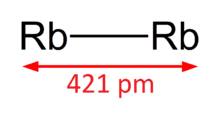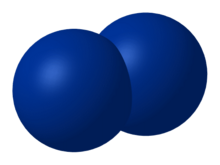Chemistry:Dirubidium

| |

| |
| Identifiers | |
|---|---|
3D model (JSmol)
|
|
| ChemSpider | |
PubChem CID
|
|
| |
| |
| Properties | |
| Rb2 | |
| Molar mass | 170.9356 g·mol−1 |
| Hazards | |
| Main hazards | Flammable |
Except where otherwise noted, data are given for materials in their standard state (at 25 °C [77 °F], 100 kPa). | |
| Infobox references | |
Dirubidium is a molecular substance containing two atoms of rubidium found in rubidium vapour. Dirubidium has two active valence electrons. It is studied both in theory and with experiment.[1] The rubidium trimer has also been observed.
Synthesis and properties
Dirubidium is produced when rubidium vapour is chilled. The enthalpy of formation (ΔfH°) in the gas phase is 113.29 kJ/mol.[2] In practice, an oven heated to 600 to 800K with a nozzle can squirt out vapour that condenses into dimers.[3] The proportion of Rb2 in rubidium vapour varies with its density, which depends on the temperature. At 200° the partial pressure of Rb2 is only 0.4%, at 400 °C it constitutes 1.6% of the pressure, and at 677 °C the dimer has 7.4% of the vapour pressure (13.8% by mass).[4]
The rubidium dimer has been formed on the surface of helium nanodroplets when two rubidium atoms combine to yield the dimer:
- Rb + Rb → Rb2
Rb2 has also been produced in solid helium matrix under pressure.[5]
Ultracold rubidium atoms can be stored in a magneto-optic trap and then photoassociated to form molecules in an excited state, vibrating at a rate so high they barely hang together.[6] In solid matrix traps, Rb2 can combine with the host atoms when excited to form exciplexes, for example Rb2(3Πu)He2 in a solid helium matrix.[7]
Ultracold rubidium dimers are being produced in order to observe quantum effects on well-defined molecules. It is possible to produce a set of molecules all rotating on the same axis with the lowest vibrational level.[8]
Spectrum
Dirubidium has several excited states, and spectral bands occur for transitions between these levels, combined with vibration. It can be studied by its absorption lines, or by laser induced-fluorescence. Laser induced-fluorescence can reveal the life-times of excited states.[1]
In the absorption spectrum of rubidium vapour, Rb2 has a major effect. Single atoms of rubidium in the vapour cause lines in the spectrum, but the dimer causes wider bands to appear. The most severe absorption between 640 and 730 nm makes the vapour almost opaque from 670 to 700 nm, wiping out the far red end of the spectrum. This is the band due to X→B transition. From 430 to 460 nm there is a shark-fin shaped absorption feature due to X→E transitions. Another shark fin like effect around 475 nm s due to X→D transitions. There is also a small hump with peaks at 601, 603 and 605.5 nm 1→3 triplet transitions and connected to the diffuse series. There are a few more small absorption features in the near infrared.[9]
There is also a dirubidium cation, Rb2+ with different spectroscopic properties.[1]
Bands
| Transition | Colour | Known vibrational bands | Bandheads |
|---|---|---|---|
| A-X | infrared | ||
| B-X | red | 4-0 5-0 6-0 7-0 8-0 9-0 10-0 11-0 6-1 7-1 8-1 9-2 | 14847.080 to 15162.002 |
| C-X | blue | ||
| D-X | blue-violet | ||
| 1-C | infrared | ||
| C→2 | 6800–8000 cm−1 | ||
| 11Δg-X | 540 nm quadrupole |
Molecular constants for excited states
The following table has parameters for 85Rb85Rb the most common for the natural element.
| Parameter | Te | ωe | ωexe | ωeye | Be | αe | γe | De | βe | re | ν00 | Re Å | ref |
|---|---|---|---|---|---|---|---|---|---|---|---|---|---|
| 31Σg+ | 5.4 Å | [10] | |||||||||||
| 43+u 5s+6s | |||||||||||||
| 33Δu 5s+4d | |||||||||||||
| 33Πu 5s + 6p | 22 610.27 | 41.4 | [11] | ||||||||||
| 23Πu | 19805.2 | 42.0 | 0.01841 | 4.6 | [11] | ||||||||
| 13Σg 5p+5s | |||||||||||||
| 13Σu 5p+5s | weak | [5] | |||||||||||
| 13Πu 5p+5s | |||||||||||||
| 2g | 13029.29 | 0.01568 | 5.0 | [12] | |||||||||
| 1g | 13008.610 | 0.0158 | 5.05 | [12] | |||||||||
| 0−g | 12980.840 | 0.0151 | 5.05 | [6][12] | |||||||||
| 0+g inner | 12979.282 | 0.015489 | 5.1 | [12] | |||||||||
| 0+g outer | 13005.612 | 0.00478 | 9.2 | [12] | |||||||||
| 0+u | [6][12] | ||||||||||||
| c3Σu+ (unbound) 5p2P3/2 | [13] | ||||||||||||
| b3Πu | |||||||||||||
| a3Σu+ metastable triplet | [6] | ||||||||||||
| a3Πu triplet ground state | [6] | ||||||||||||
| 141Σg+ | 30121.0 | 44.9 | 0.01166 | pred[11] | |||||||||
| 131Σg+ | 28 863.0 | 46.1 | 0.01673 | pred[11] | |||||||||
| 121Σg+ | 28 533.9 | 38.4 | 0.01656 | pred[11] | |||||||||
| 111Σg+ | 28 349.9 | 42.0 | 0.01721 | pred[11] | |||||||||
| 101Σg+ | 27 433.1 | 45.3 | 0.01491 | pred[11] | |||||||||
| 91Σg+ | 26 967.1 | 45.1 | 0.01768 | pred[11] | |||||||||
| 81Σg+ | 26 852.9 | 44.6 | 0.01724 | pred[11] | |||||||||
| 71Σg+ | 25 773.9 | 76.7 | 0.01158 | pred[11] | |||||||||
| 61Σg+ | 24 610.8 | 46.3 | 0.01800 | pred[11] | |||||||||
| 111Σu+ | 29 709.4 | 41.7 | 0.01623 | pred[11] | |||||||||
| 101Σu+ | 29 339.2 | 35.0 | 0.016 85 | pred[11] | |||||||||
| 91Σu+ | 28 689.9 | 43.6 | 0.01661 | pred[11] | |||||||||
| 81Σu+ | 28 147.3 | 51.5 | 0.01588 | pred[11] | |||||||||
| 71Σu+ | 27 716.8 | 44.5 | 0.01636 | pred[11] | |||||||||
| 61Σu+ | 26 935.8 | 49.6 | 0.01341 | pred[11] | |||||||||
| 51Σu+ | 26108.8 | 39 | 0.016 47 | 4.9 | [11][14] | ||||||||
| 51Πu | 26131 | 4.95 | [14] | ||||||||||
| 41Σu+ | 24 800.8 | 10.7 | 0.00298 | pred[11] | |||||||||
| 41Σg+ | 20004.13 | 61.296 | 0.01643 | [11] | |||||||||
| 31Σu+ 5s+6s | 22 405.2 | 40.2 | 0.015 536 | [11] | |||||||||
| 31Πu = D1Πu 5s + 6p | 22777.53 | 36.255 | 0.01837 | 5008.59 | 4.9 Å | [15] | |||||||
| 21Σg+ | 13601.58 | 31.4884 | -0.01062 | 0.013430 | -0.0000018924 | 2963 | 5.4379 | [16] | |||||
| 21Σu+ 6s+4d | 5.5 (vibration causes a large stretching) | [6] | |||||||||||
| 21Πu = C1Πu | 20 913.18 | 36.255 | 0.01837 | [11] | |||||||||
| 21Πg | 22 084.9 | 30.6 | 0.01441 | [11] | |||||||||
| 11Δg | |||||||||||||
| 11Πu | |||||||||||||
| 11Πg | 15510.28 | 22.202 | -0.1525 | 0.013525 | -0.0001209 | 1290 cm−1 | 5.418 | [13] | |||||
| B1Πu 5s+5p | 14665.44 | 47.4316 | 0.1533 | 0.0060 | 0.01999 | 0.000070 | 1.4 | [3] | |||||
| A1Σu+ 5s+5p | 10749.742 | 44.58 | 4.87368 Å | [17] | |||||||||
| X1Σg+ 5s+5s | 12816 | 57.7467 | 0.1582 | 0.0015 | 0.02278 | 0.000047 | 1.5/3986 cm−1 | 4.17 | [3][16] |
Related species
The other alkali metals also form dimers: dilithium Li2, Na2, K2, and Cs2. The rubidium trimer has also been observed on the surface of helium nanodroplets. The trimer, Rb3 has the shape of an equilateral triangle, bond length of 5.52 A˚ and a binding energy of 929 cm−1.[18]
References
- ↑ 1.0 1.1 1.2 Spiegelmann, F; Pavolini, D; Daudey, J -P (28 August 1989). "Theoretical study of the excited states of the heavier alkali dimers. II. The Rb molecule". Journal of Physics B: Atomic, Molecular and Optical Physics 22 (16): 2465–2483. doi:10.1088/0953-4075/22/16/005. Bibcode: 1989JPhB...22.2465S.
- ↑ Chase, M. W. (1998) (in en). Dirubidium. pp. 1–1951. http://webbook.nist.gov/cgi/inchi?ID=C25681816&Mask=1#Thermo-Gas.
- ↑ 3.0 3.1 3.2 Caldwell, C.D.; Engelke, F.; Hage, H. (December 1980). "High resolution spectroscopy in supersonic nozzle beams: The Rb2 B 1Πu-X 1Σ+g band system". Chemical Physics 54 (1): 21–31. doi:10.1016/0301-0104(80)80031-0. Bibcode: 1980CP.....54...21C.
- ↑ Rakića, M.; Pichler, G. (March 2008). "Photoionization bands of rubidium molecule". Journal of Quantitative Spectroscopy and Radiative Transfer 208: 39–44. doi:10.1016/j.jqsrt.2018.01.003. Bibcode: 2018JQSRT.208...39R.
- ↑ 5.0 5.1 Moroshkin, P.; Hofer, A.; Ulzega, S.; Weis, A. (7 September 2006). "Spectroscopy of Rb2 dimers in solid". Physical Review A 74 (3): 032504. doi:10.1103/PhysRevA.74.032504. Bibcode: 2006PhRvA..74c2504M.
- ↑ 6.0 6.1 6.2 6.3 6.4 6.5 Huang, Y; Qi, J; Pechkis, H K; Wang, D; Eyler, E E; Gould, P L; Stwalley, W C (14 October 2006). "Formation, detection and spectroscopy of ultracold Rb2 in the ground X 1Σg state". Journal of Physics B: Atomic, Molecular and Optical Physics 39 (19): S857–S869. doi:10.1088/0953-4075/39/19/S04. Bibcode: 2006JPhB...39S.857H.
- ↑ Moroshkin, P.; Hofer, A.; Ulzega, S.; Weis, A. (7 September 2006). "Spectroscopy of Rb2 dimers in solid 4He". Physical Review A 74 (3): 032504. doi:10.1103/PhysRevA.74.032504. Bibcode: 2006PhRvA..74c2504M.
- ↑ Shore, Bruce W; Dömötör, Piroska; Sadurní, Emerson; Süssmann, Georg; Schleich, Wolfgang P (27 January 2015). "Scattering of a particle with internal structure from a single slit". New Journal of Physics 17 (1): 013046. doi:10.1088/1367-2630/17/1/013046. Bibcode: 2015NJPh...17a3046S.
- ↑ Vdović, S.; Sarkisyan, D.; Pichler, G. (December 2006). "Absorption spectrum of rubidium and cesium dimers by compact computer operated spectrometer". Optics Communications 268 (1): 58–63. doi:10.1016/j.optcom.2006.06.070. Bibcode: 2006OptCo.268...58V.
- ↑ Yang, Jinxin; Guan, Yafei; Zhao, Wei; Zhou, Zhaoyu; Han, Xiaomin; Ma, Jie; Sovkov, Vladimir B.; Ivanov, Valery S. et al. (14 January 2016). "Observations and analysis with the spline-based Rydberg–Klein–Rees approach for the 31Σg+ state of Rb2". The Journal of Chemical Physics 144 (2): 024308. doi:10.1063/1.4939524. PMID 26772572. Bibcode: 2016JChPh.144b4308Y.
- ↑ 11.00 11.01 11.02 11.03 11.04 11.05 11.06 11.07 11.08 11.09 11.10 11.11 11.12 11.13 11.14 11.15 11.16 11.17 11.18 11.19 11.20 11.21 11.22 Jastrzebski, Wlodzimierz; Kowalczyk, Pawel; Szczepkowski, Jacek; Allouche, Abdul-Rahman; Crozet, Patrick; Ross, Amanda J. (28 July 2015). "High-lying electronic states of the rubidium dimer – predictions and experimental observation of the 51Σu+ and 5 Π states of Rb by polarization labelling spectroscopy". The Journal of Chemical Physics 143 (4): 044308. doi:10.1063/1.4927225. PMID 26233130. Bibcode: 2015JChPh.143d4308J.
- ↑ 12.0 12.1 12.2 12.3 12.4 12.5 Bellos, M. A.; Rahmlow, D.; Carollo, R.; Banerjee, J.; Dulieu, O.; Gerdes, A.; Eyler, E. E.; Gould, P. L. et al. (2011). "Formation of ultracold Rb2 molecules in the v′′ = 0 level of the a3Σ+u state via blue-detuned photoassociation to the 13Πg state". Physical Chemistry Chemical Physics 13 (42): 18880–18886. doi:10.1039/C1CP21383K. PMID 21909578. Bibcode: 2011PCCP...1318880B.
- ↑ 13.0 13.1 Amiot, C. (July 1986). "The Rb2 1 1Πg electronic state by laser-induced fluorescence infrared Fourier transform spectroscopy". Molecular Physics 58 (4): 667–678. doi:10.1080/00268978600101491. Bibcode: 1986MolPh..58..667A.
- ↑ 14.0 14.1 Havalyova, I.; Pashov, A.; Kowalczyk, P.; Szczepkowski, J.; Jastrzebski, W. (November 2017). "The coupled system of (5)1sigmau+ and (5) 1 Π u electronic states in Rb 2". Journal of Quantitative Spectroscopy and Radiative Transfer 202: 328–334. doi:10.1016/j.jqsrt.2017.08.011. Bibcode: 2017JQSRT.202..328H.
- ↑ Jastrzebski, W.; Kowalczyk, P. (December 2016). "Potential energy curve of the D(3) 1Πu state in rubidium dimer from spectroscopic measurements". Journal of Molecular Spectroscopy 330: 96–100. doi:10.1016/j.jms.2016.06.010. Bibcode: 2016JMoSp.330...96J.
- ↑ 16.0 16.1 Amiot, C.; Verges, J. (May 1987). "The Rb2 21Σ+g electronic state by laser induced fluorescence infrared Fourier transform spectroscopy". Molecular Physics 61 (1): 51–63. doi:10.1080/00268978700100981. Bibcode: 1987MolPh..61...51A.
- ↑ Cite error: Invalid
<ref>tag; no text was provided for refs namedsalami - ↑ Nagl, Johann; Auböck, Gerald; Hauser, Andreas W.; Allard, Olivier; Callegari, Carlo; Ernst, Wolfgang E. (13 February 2008). "Heteronuclear and Homonuclear High-Spin Alkali Trimers on Helium Nanodroplets". Physical Review Letters 100 (6): 063001. doi:10.1103/PhysRevLett.100.063001. PMID 18352466. Bibcode: 2008PhRvL.100f3001N.
 |
